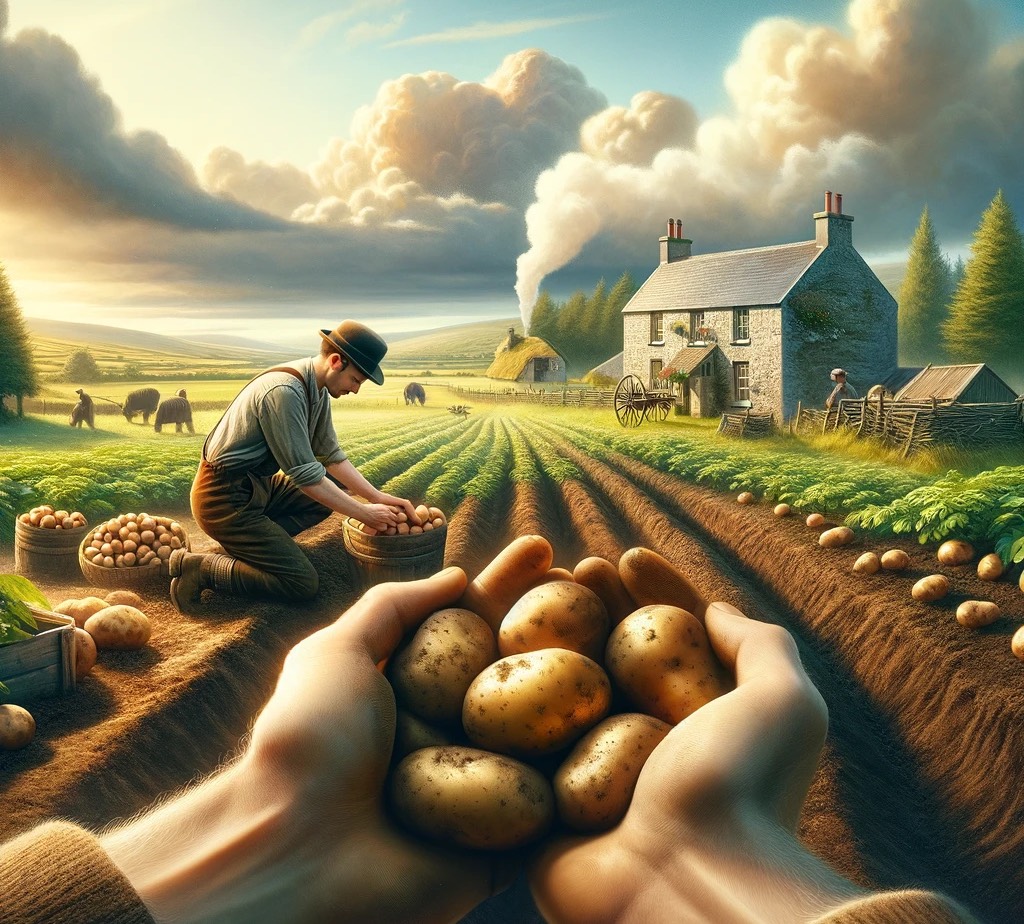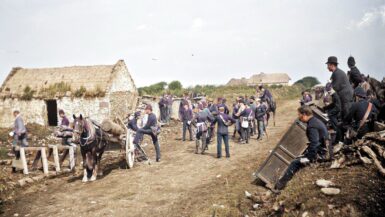The humble potato, a tuber native to South America, has played a pivotal role in the tapestry of Irish history and culture. This seemingly simple crop not only reshaped the agricultural landscape of Ireland but also became a cornerstone of Irish society, economy, and cuisine. Its introduction brought about profound changes, influencing everything from dietary habits to social structures, and even impacting the nation’s demographic trends.
In the annals of Irish history, the potato is more than just a food source; it’s a symbol of both prosperity and hardship. It played a key role in sustaining the population through periods of growth, yet also figured centrally in one of the most tragic events in Irish history: the Great Famine. The story of the potato in Ireland is a tale of how a single crop can influence the fate of a nation, weaving itself into the very fabric of its cultural identity.
Contents
The Arrival of the Potato in Ireland
Historical Background
The potato made its way to Europe from the Andes in South America in the second half of the 16th century, brought by Spanish explorers. However, it wasn’t until the late 16th or early 17th century that this new crop reached the shores of Ireland. The exact details of its introduction remain a subject of debate among historians. Some suggest it was brought by the Spanish Armada, others by Sir Walter Raleigh or Sir Francis Drake. Regardless of its precise origin story, the potato soon found a welcoming environment in the Irish soil and climate.
Early Adoption and Spread
Initially viewed with suspicion due to its non-native origin and unfamiliarity, the potato gradually gained acceptance in Ireland. Its ability to produce high yields in less fertile soil made it an attractive crop, especially in regions where traditional cereals like wheat and barley struggled. The potato’s efficiency in feeding large families from small plots of land made it particularly appealing in a country where land ownership and access were highly restricted.
By the 18th century, the potato had become a staple in the Irish diet. Its cultivation spread rapidly across the country, transforming not just the landscape but also the daily lives of the Irish people. Small tenant farmers, who made up the majority of the population, relied heavily on this crop for their sustenance. The ease of growing potatoes and their nutritional value supported a population boom in Ireland, setting the stage for the profound impact this humble tuber would have on Irish history and culture.
The Potato in Irish Agriculture
The Importance in Farming Practices
The introduction of the potato revolutionized Irish agriculture in several significant ways. Its ability to thrive in varied and less fertile soil conditions made it a particularly appealing crop for Ireland’s often challenging agricultural environment. The potato’s high yield per acre compared to grains meant that even the smallest plots of land could provide a substantial food source. This aspect was crucial in a country where land ownership was concentrated in the hands of a few, leaving the majority of the population to work as tenant farmers on very limited land.
Potatoes also altered the traditional crop rotation systems. Unlike grains, which depleted the soil of certain nutrients, potatoes could be grown repeatedly on the same plot of land without exhausting its fertility. This was a game-changer for Irish farmers, allowing them to maximize the utility of their land.
Changes in Agricultural Techniques
The cultivation of potatoes led to changes in farming methods. The traditional open-field system of agriculture, which was common for cereal crops, gave way to more intensive and focused cultivation practices suited to potato farming. This included the ‘lazy bed’ method, where potatoes were planted in ridges or raised beds to improve drainage and yield. Such techniques were labor-intensive but highly effective in maximizing the productivity of small plots of land.
Nutritional and Economic Impact
Nutritional Value and Diet
The potato rapidly became the backbone of the Irish diet due to its high carbohydrate content and nutritional value. It was a source of vitamins C and B6, potassium, and fiber, which were essential in a diet otherwise lacking in variety. For the majority of the population, particularly the poor, potatoes paired with dairy products like milk or butter formed a complete diet. This diet was relatively healthy and sustained a rapidly growing population.
Economic Implications
Economically, the potato had a profound impact on Irish society. Its cultivation required less labor and capital investment compared to grains, making it accessible to the poorest sections of society. The profitability of potato farming, especially for tenant farmers, was higher than that of cereal crops. This economic advantage, however, also led to a dangerous dependency on a single crop.
The reliance on the potato as a primary food source was a double-edged sword. While it initially boosted population growth and provided food security, it also made the Irish economy and its people vulnerable to any threat to the potato crop. This vulnerability became tragically evident during the Great Famine, when potato blight led to widespread starvation and emigration. The economic and social fabric of Ireland was forever altered by the potato, underscoring its immense impact on Irish history.
Potatoes and Irish Culture
Influence on Irish Culinary Traditions
The potato’s integration into Irish life went far beyond agriculture, deeply influencing culinary traditions. It became the centerpiece of the Irish diet, with dishes like colcannon (mashed potatoes with kale or cabbage), boxty (potato pancakes), and Irish stew (potatoes, meat, and vegetables) becoming staples. These dishes were not only nourishing but also reflected the adaptability and resourcefulness of Irish cooks in creating varied meals from a limited range of ingredients. The simplicity and heartiness of potato-based dishes resonated with the life and struggles of ordinary people, making these recipes an integral part of Irish culinary heritage.
Folklore, Customs, and Cultural Practices
The potato’s significance in Irish life is also evident in folklore and cultural practices. Many superstitions and traditions revolved around potato planting and harvesting. For example, it was believed that potatoes should be planted on Good Friday to ensure a good harvest. Harvest time, known as Lughnasadh in the Gaelic calendar, was marked by community celebrations and feasting, where potatoes often featured prominently.
The potato also found its way into Irish literature, songs, and sayings, reflecting its central place in daily life. Phrases like “To hell or to Connaught” emerged during the Cromwellian resettlement, underscoring the reliance on potato cultivation in less fertile lands in the west of Ireland.
The Great Famine (1845-1849)
Causes and Onset
The Great Famine, also known as the Irish Potato Famine, was one of the darkest periods in Irish history, and it was directly linked to the potato. The famine was caused by a disease known as potato blight (Phytophthora infestans), which originated in the Americas. This fungal disease rapidly spread throughout Europe but had a catastrophic impact in Ireland due to the near-total reliance on the potato as a food source.
The first signs of blight appeared in 1845, destroying approximately one-third of that year’s potato crop. In the following years, almost the entire potato crop was wiped out, leading to severe food shortages.
Devastating Impact on Society and Economy
The impact of the Great Famine on Irish society and economy was devastating. With the primary food source gone, starvation and disease quickly spread across the country. The famine led to the death of approximately one million people from starvation and related diseases. Another million emigrated in a desperate search for survival, significantly reducing Ireland’s population and leading to a century-long population decline.
The famine exposed the weaknesses in British governance and land tenure systems in Ireland, aggravating political tensions and contributing to a growing nationalist movement. The social effects of the famine were profound and long-lasting, with a deep psychological impact on the Irish people and their relationship with the land. The Great Famine remains a pivotal event in Irish history, a symbol of suffering and resilience, and a turning point that shaped the nation’s future.
Emigration and the Famine’s Aftermath
Mass Emigration and Global Impact
The Great Famine not only decimated Ireland’s population through death but also triggered one of the largest mass emigrations in history. Between 1845 and 1855, over a million Irish people left their homeland, primarily to North America, Britain, and Australia. These emigrants carried with them not just the trauma of the famine but also their culture, traditions, and stories, significantly influencing the societies they joined. Cities like Boston and New York saw a substantial increase in Irish populations, which left lasting impacts on the cultural and political landscapes of these places.
This diaspora created a global network of Irish communities, fostering a sense of Irish identity that transcended national boundaries. It also contributed to a greater awareness of social and political issues, influencing movements for reform both in Ireland and in the countries to which the Irish emigrated.
Long-term Effects on Irish Demography, Economy, and Society
The famine and subsequent emigration had profound long-term effects on Irish demography, economy, and society. The population decline changed the demographic landscape of Ireland, with some areas experiencing a significant decrease in population density. Economically, the famine led to a shift in land use and farming practices, with a gradual move away from subsistence agriculture towards pastoral farming. This shift was partly influenced by the decline in population and the need for less labor-intensive farming methods.
Socially, the famine exacerbated tensions between Ireland and Britain, fueling nationalist sentiments and the push for Irish independence. It also altered the social structure of Ireland, leading to changes in land ownership and farming practices, and had a lasting impact on the collective memory and identity of the Irish people.
Recovery and the Potato’s Legacy
Recovery from the Famine
Recovery from the Great Famine was a slow and arduous process. Gradually, the Irish economy and agriculture began to diversify, reducing the reliance on a single crop. Efforts were made to improve agricultural practices and to promote other crops alongside potatoes. The late 19th and early 20th centuries saw a gradual improvement in living standards, although the scars of the famine remained deeply ingrained in the national psyche.
The Continued Role and Modern Perspectives
Despite the trauma associated with the famine, the potato remained an important crop in Ireland. Its ease of cultivation and nutritional value continued to make it a staple in the Irish diet. However, the approach to potato farming and consumption became more balanced and cautious, with a greater emphasis on crop diversity and food security.
In modern Ireland, the potato still holds a significant place in Irish cuisine and culture. Dishes like colcannon and boxty remain popular, and the potato is celebrated through various festivals and cultural events.
From a historical perspective, the potato is seen as both a symbol of survival and a reminder of the dangers of over-reliance on a single food source. Its story is a testament to the resilience of the Irish people, reflecting their capacity to endure hardship and adapt to changing circumstances. The legacy of the potato in Ireland is thus a complex tapestry, woven with threads of tragedy, endurance, and adaptability, encapsulating key aspects of the Irish experience.
The Potato in Modern Ireland
Current Status of Potato Farming
In today’s Ireland, potato farming continues to be a vital part of agriculture, albeit with significant changes from the past. Modern farming techniques, improved varieties resistant to diseases like blight, and a more diversified agricultural system have helped stabilize potato production. Ireland’s potato industry now focuses not only on producing potatoes for consumption but also on seed potato production, adhering to high-quality and safety standards. Despite the decrease in the total area under potato cultivation compared to historical figures, the potato remains a significant crop in Ireland’s agricultural landscape.
Role in Contemporary Irish Cuisine and Culture
In contemporary Irish culture, the potato maintains its status as a beloved staple. Modern Irish cuisine continues to feature potatoes in various traditional and innovative dishes. Restaurants and home cooks alike cherish the versatility of potatoes, using them in everything from classic comfort foods to gourmet creations. The potato also plays a role in the tourism industry, with many visitors eager to experience authentic Irish potato dishes.
Educational and Cultural Initiatives
Museums, Memorials, and Educational Programs
Ireland has taken significant steps to preserve and educate about the history of the potato and its impact. Museums and memorials dedicated to the Great Famine, such as the National Famine Museum at Strokestown Park and the Irish Famine Exhibition in Dublin, offer insights into the potato’s role in Irish history. These institutions serve as poignant reminders of the famine’s impact and educate visitors about the broader historical, social, and agricultural contexts.
Educational programs in schools and communities often include discussions about the potato famine and its lasting effects on Ireland. These initiatives help in fostering an understanding of this crucial period in Irish history among younger generations.
Festivals and Events Celebrating the Potato
The cultural significance of the potato is celebrated in various festivals and events throughout Ireland. The Poc Fada, an ancient Irish sporting event, literally translates to “long throw” and traditionally involved throwing a potato. Although the modern version uses a sliotar (hurling ball), the historical connection to potatoes is still remembered.
Annual events like the Carlow Potato Festival celebrate the potato with markets, cooking demonstrations, and competitions. Such festivals not only honor the potato’s place in Irish heritage but also promote local potato varieties and farming communities, showcasing the enduring legacy of this humble crop in Irish culture.
Conclusion
The story of the potato in Ireland is a profound narrative of resilience, adaptability, and transformation. From its introduction in the 16th century to its present-day significance, the potato has been more than just a staple food—it has been a key player in shaping the course of Irish history and the contours of its culture. The legacy of the potato in Ireland is multifaceted, reflecting both periods of abundance and times of unimaginable hardship.
The potato’s influence extends beyond the fields and into the hearts and homes of the Irish people. It has shaped culinary traditions, inspired folklore and customs, and played a central role in one of the most tragic episodes in Irish history. The Great Famine, precipitated by the failure of the potato crop, left an indelible mark on the nation, triggering widespread suffering, emigration, and societal change. Yet, the recovery from this catastrophe and the continued cultivation of potatoes symbolize the resilience and perseverance of the Irish people.
In modern Ireland, the potato continues to be a symbol of national identity and a staple in Irish cuisine. It represents a connection to the past, a testament to survival, and a reminder of the importance of diversity and sustainability in agriculture and diet.
Educational and cultural initiatives that commemorate the potato’s history underscore its significance in the collective memory of the Irish people. Festivals and exhibitions celebrate the potato’s role in Irish heritage, ensuring that its story is passed down through generations.
Ultimately, the enduring legacy of the potato in Irish history and culture is a narrative of human endurance and adaptability. It is a story that resonates beyond Ireland, speaking to the broader themes of human interaction with the environment, the impact of agricultural practices on society, and the capacity of a nation to overcome adversity. The potato, in its simplicity, continues to be a powerful symbol of Irish identity, heritage, and the unyielding spirit of its people.






Interesting article. Regrettably very weak on diagnosing the antecedent causes of how a population of 8 million people could be made so vulnerable and decimated by the genocidal centuries of British Colonial Oppression & Exploitation. UK population 16 million then; now 65. Ireland 5.5 !! By comparison it should be 30 plus